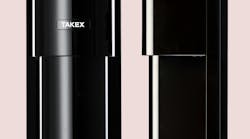Now that all of these factors in the second part of our article on false alarms have been presented, what are the next steps?
First there is a need for explanation of some of the problems we face in the electrical environment in which we live.
Power line noise is, and always has been, a natural by-product of making electricity, its distribution and its use. If the demand for power increases beyond the capacity of the company's generator in one area, or if heavy industry overloads the system, the corrective action taken by the electric company can cause spikes and transients to appear on the power line. This process is known as "notching" or "grid switching". The electric companies try to carry it off smoothly, but it usually results in a "notch," which is a brief dropout in power that is followed by a brief surge as normal power is restored.
There is also the "power faction connection." This is a process of switching capacitor banks in and out to compensate for heavy industrial loads. It also causes a brief burst of electrical noise.
Lightning strikes are not the most common source of power-line noise, but they are certainly the most devastating. Even when the strike is many miles away, surges and spikes measuring thousands of volts may show up at electrical receptacles. Mark Twain once remarked that, "Thunder got all of the credit for the noise, when it was actually the lightning that did all of the work." Well, as dramatic as lightning is, and it draws more than its share of attention when it comes to power line disturbances, on a day-to-day basis, far more electrical noise is created right in our buildings and homes by noisy electrical loads.
Fluorescent lights, copiers, electric typewriters, heating, ventilating and air conditioning, coffee makers, power tools, arc welders, vending machines, and other like tools and appliances generate noise that goes back into the electrical system as they operate. All electrical loads make some noise, at least when they are turned on and off. The noisiest are those that have high peak current demands -- those that have inductive components, such as electric motors or solenoids, especially those that use solid state switching devices, such as those found in thermostats and light dimmers. And don't forget, computerized systems with their peripherals are frequently a part of the problem, not just victims of it. Computer monitors, disk drives, and printers, for example, frequently have large start-up current requirements that can cause transients to travel to and from the peripherals.
Why then are today's systems so much more sensitive than they used to be?
Well, during the past 10 years most computer manufacturers have changed from using linear DC power supplies to modern switch-mode or switching power supplies. The switching power supplies are lighter, smaller, more efficient, and insensitive to changes in power line voltage. However -- and its always the "however" that gets you -- since they operate by switching on and off rapidly and drawing a lot of current during each cycle, they can generate a lot of noise if they are not connected to a very low-impedance power source. Inadequate wiring or some other high-impedance power source is usually the problem here. The other big problem is chips themselves are more vulnerable to noise than they used to be. Why? In each new generation we pack more and more transistors into the same microscopic space. And as the individual transistors get smaller and smaller, the amount of electrical overstress they can survive gets lower and lower. Modern semiconductor devices can now be disrupted by as little as half a volt of noise. Over 10 volts of noise starts to destroy them.
What's the bottom line? Power line noise enters a computer from two sources-normal mode and common mode. Normal mode noise is a noise voltage potential between line and neutral. Common mode noise is a noise voltage potential between line and neutral and ground. Computers are better protected against normal mode noise than they are against common mode noise.
Normal mode noise has to pass through the system's power supply where at least some of it will be filtered out before it reaches the circuit boards.
In addition, the AC electrical system was designed to protect itself and its loads against normal mode noise. How? There's good news: It does this by shorting itself out at the high voltages and high frequencies of power line noise, and dumping excess energy to ground. But there's the bad news, too: Because of this, most of the normal mode noise is converted into common mode noise.
Common mode noise is harmless to most of the loads that the power system was designed to operate, because they only use the ground wire as an alternate path back to ground for safety reasons. Unfortunately, modern computer systems and their peripherals use ground as a reference point and common mode noise is a serious threat to them. In a typical system, the safety ground is either directly or through a capacitive manner coupled to the computer's logic reference ground. If more than a half a volt of noise gets into the ground bus, it will disrupt system operations. This is why a very quiet ground is required for any computerized system. The vulnerability of computerized systems to power problems is well documented. Several studies have shown that up to 80 percent of all computer failures are power related. Removing noise from the electrical environment is one of the most important things that you can do to improve a system's reliability.
How do we effectively remove noise from electrical power? We apply the same principles to electricity that we apply to gasoline, oil, air, or water -- we filter it and we condition it. There is a lot of confusion about the meaning of the words "power conditioning." The public at large and we security professionals confuse power conditioning with other devices, such as surge suppressors, voltage regulators, spike arrestors, EMI/RFI filters, and so on. Most of these devices are designed to treat one or two symptoms of noisy power. A true power conditioner should protect a system completely from all the effects of power line disturbances. There are four leading technologies for industrial power conditioning. Those would be the following: isolation transformers, ferroresonant (constant-voltage) regulators, electronic tap-changing regulators, and low-impedance power conditioners.
The next step should be a comprehensive evaluation of the electrical system ' and I do mean comprehensive!
The best thing to do is to have a full range power monitor plugged into the wall receptacle and monitor conditions for a full week. I strongly recommend plugging it in on a Sunday morning and unplugging it on the following Saturday morning. Instructions are implicit -- the monitor it is to be left undisturbed. The tape should be kept rolled up.
Someone can do that once in the morning and just prior to locking the doors at night. When the test is complete, the machine is turned off, the tape collected, and the analysis made. The written report will pinpoint the problems as they occurred and recommend corrective action. If there were short-term power outages or very low voltage conditions, which amounts to the same thing, then an uninterruptible power supply may be required. The report may determine that grounding must be improved. Certain tests may be recommended. We strongly recommend they be completed before any improvements are undertaken. Power conditioning will accomplish wonderful things, but it will not work to its maximum potential without good low resistive grounding.
The completed survey is to facilitate site preparation or site restoration for installing or restoring of a reliable and effective alarm system, free of false and nuisance alarms. There is proof that thorough site preparation, proper sensor selection, installation methods and techniques, along with owner/operator education and training, incidences of false and nuisance alarms are significantly reduced. Scarce security and law enforcement resources can be effectively utilized in either a proactive manner, or squandered by responding to spurious alarms. With a proper plan of action that takes into account potential alarm system disruptions, those calls will more likely be for real incidents rather than nuisance alarms.
Related Articles:

